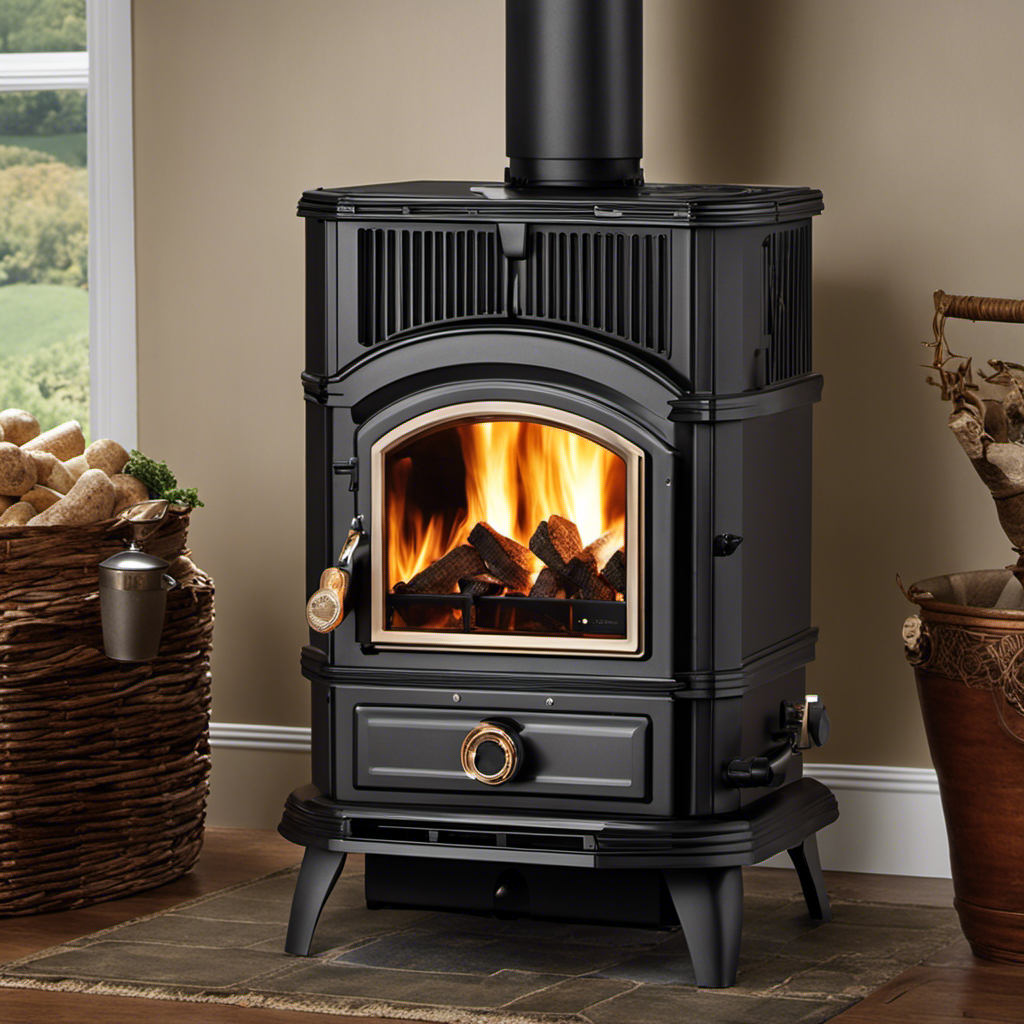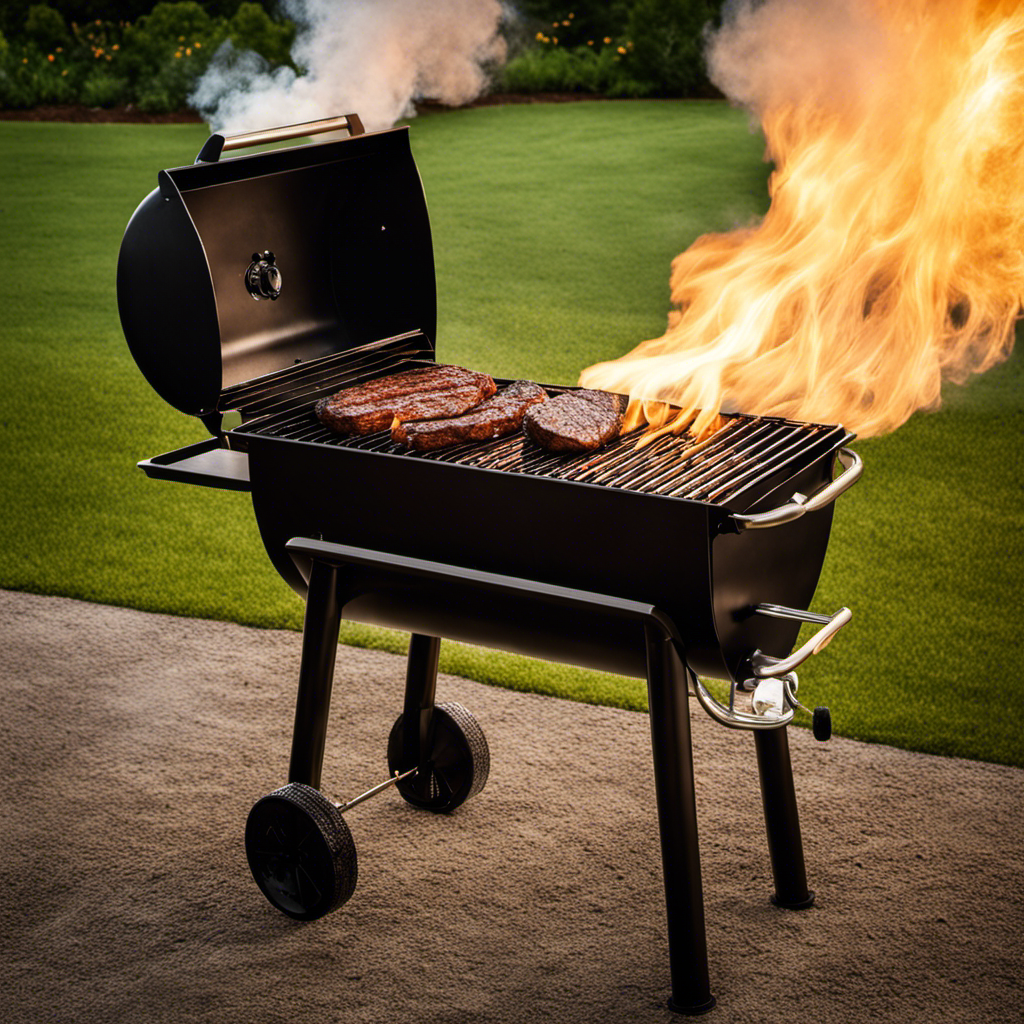I’ve found the best method to manage the fuel for my pellet stove: producing my own wood pellets.
It may sound like an ambitious endeavor, but with the right tools and techniques, anyone can do it.
In this article, I’ll guide you through the detailed process of producing high-quality wood pellets right at home.
From choosing the perfect wood to testing the final product, I’ll share my technical knowledge and experience to help you become a master pellet maker.
Get ready to revolutionize your pellet stove experience!
Key Takeaways
- Select wood with the right moisture content for optimal pellet production.
- Use proper grinding equipment to achieve desired sawdust size and consistency.
- Binders and lubricants improve pellet quality and ensure smooth pellet movement.
- Regularly monitor and control moisture content during the pelletizing process for consistent pellet quality and efficiency.
Choosing the Right Wood for Pellet Making
When choosing the right wood for pellet making, it’s important to consider the moisture content. Wood pellet suppliers often provide wood with a moisture content of around 10-20%. This is ideal for pellet production as it ensures better heating efficiency and combustion. Wood with higher moisture content will require more energy to dry, decreasing the overall efficiency of the pellet making process.
On the other hand, wood with very low moisture content may result in pellets that are too dry and brittle, leading to poor combustion and reduced heating efficiency. Therefore, it is crucial to select wood with the right moisture content to achieve optimal results in pellet production.
Now that we understand the importance of moisture content, let’s move on to preparing the wood for pellet production.
Preparing the Wood for Pellet Production
Start by ensuring that you have properly prepared the wood for production. This is a crucial step in making high-quality wood pellets for your pellet stove. Here are three important considerations to keep in mind:
-
Wood pellet moisture content: Before producing pellets, it’s essential to dry the wood to the appropriate moisture content. Ideally, the moisture content should be below 10%. This ensures optimal pellet quality and combustion efficiency.
-
Types of wood for pellet production: Different wood species have varying characteristics that can affect the quality of the pellets. Hardwoods like oak and maple are popular choices due to their high energy content and low ash production. Softwoods like pine and fir, on the other hand, ignite quickly and produce a consistent flame.
-
Proper storage and handling: To maintain the wood’s moisture content, it’s crucial to store it in a dry and well-ventilated area. Avoid exposure to excessive moisture or direct sunlight, as this can lead to mold growth and degradation of the wood.
Now that the wood is properly prepared, the next step is grinding the wood into sawdust. This process breaks down the wood into small particles, which are then compressed into pellets.
Grinding the Wood Into Sawdust
When it comes to grinding wood into sawdust for pellet production, there are several key points to consider.
First, the equipment used for grinding is crucial in achieving the desired results. It is important to select a grinder that can effectively break down the wood and produce a consistent size of sawdust.
Additionally, understanding the sawdust size requirements is essential for pellet production. Different pellet mills may have specific size requirements for the sawdust, so it is important to ensure that the grinder produces the appropriate size.
Equipment for Grinding?
You’ll need a grinder to turn the wood into small particles for making wood pellets. When it comes to grinding techniques and equipment selection, there are several options to consider. The table below outlines three common types of grinders used for this purpose:
| Grinder Type | Description | Advantages |
|---|---|---|
| Hammer Mill | Uses rotating hammers to pulverize the wood | High production capacity, versatile |
| Disc Mill | Utilizes spinning discs to shred the wood into particles | Precise control over particle size, low energy consumption |
| Tub Grinder | Grinds the wood using a large rotating tub | Suitable for processing large volumes of material, easy maintenance |
Each grinder type has its own unique advantages, so choosing the right one depends on factors such as the desired particle size, production capacity, and available resources. Now, let’s move on to discussing the sawdust size requirements for making high-quality wood pellets.
Sawdust Size Requirements?
The size of the sawdust is an important factor to consider for producing high-quality wood pellets. Properly sized sawdust ensures that the pellets will have the right density and moisture content, which are crucial for efficient combustion and minimal ash production. Here are four key considerations regarding sawdust size:
-
Particle size distribution: The sawdust should have a consistent particle size distribution to ensure uniform pellet formation and combustion.
-
Moisture content: The sawdust should have an optimal moisture content, typically around 10-15%, to facilitate pelletization and prevent excessive energy consumption during drying.
-
Fine particles: Excessive fines in the sawdust can lead to poor pellet quality and reduced pellet density. It is important to remove these fines through proper screening.
-
Pellet density: The size of the sawdust particles influences the density of the resulting pellets. Higher density pellets provide better energy output and combustion efficiency.
Considering these factors, it is evident that sawdust size plays a critical role in the production of high-quality wood pellets. Once the sawdust is properly sized, the next step is to optimize the grinding techniques for achieving the desired particle size distribution.
Optimal Grinding Techniques?
To achieve optimal grinding techniques, it’s important to adjust the speed and feed rate of the grinder. The grinding speed refers to how fast the grinder rotates, while the feed rate determines how quickly the material is fed into the grinder. Finding the right balance between these two factors is crucial for achieving consistent and efficient grinding results.
| Grinding Speed | Grinding Consistency |
|---|---|
| High | Fine, consistent |
| Medium | Moderate |
| Low | Coarse, inconsistent |
By adjusting the grinding speed and feed rate, you can control the particle size and uniformity of the ground material. A higher grinding speed combined with a lower feed rate will result in finer and more consistent grinding. On the other hand, a lower grinding speed and higher feed rate will produce coarser and less consistent grinding.
Now that we have achieved optimal grinding techniques, the next step is to add binders and lubricants to the sawdust.
Adding Binders and Lubricants to the Sawdust
Mixing binders and lubricants into your sawdust helps to improve the quality of your wood pellets. By adding binders, such as vegetable oil or cornstarch, you can enhance the durability and density of the pellets. This is crucial for pellet stove efficiency, as denser pellets produce more heat and burn more efficiently.
Lubricants, like vegetable oil or glycerin, are also essential in the pellet-making process. They help to reduce friction during pelletization, preventing the sawdust from sticking and clogging the equipment. Additionally, lubricants aid in the smooth movement of the pellets in the hopper and auger, ensuring a continuous and consistent flow.
Now that we have discussed the importance of binders and lubricants, let’s move on to the next section: pelletizing the sawdust into wood pellets.
Pelletizing the Sawdust Into Wood Pellets
When it comes to pelletizing sawdust into wood pellets, there are several benefits to consider.
Firstly, pelletizing not only increases the density of the material, making it easier to transport and store, but it also enhances the combustion efficiency of the pellets.
Secondly, to successfully pelletize sawdust, you will need specific equipment such as a pellet mill, which can compress the sawdust into the desired pellet shape, and a dryer to ensure the moisture content is suitable for pelletizing.
Lastly, to ensure efficient pelletizing, it is important to consider factors such as the size and moisture content of the sawdust, the proper operation of the equipment, and regular maintenance of the pellet mill to prevent any issues or downtime.
Benefits of Pelletizing
The benefits of pelletizing include reducing waste and increasing energy efficiency. By converting sawdust into wood pellets, we can maximize the utilization of wood resources while minimizing environmental impact. Here are the advantages and disadvantages of pelletizing:
| Advantages | Disadvantages |
|---|---|
| 1. Reduces waste | 1. Initial investment |
| 2. Increases energy efficiency | 2. Requires maintenance |
| 3. Provides a compact and uniform fuel source | 3. Dependence on raw material availability |
| 4. Easy storage and transportation | 4. Potential for pellet quality issues |
Pelletizing offers the advantage of reducing waste by utilizing sawdust, a byproduct of wood processing. It also increases energy efficiency by producing pellets with a higher energy content compared to raw sawdust. Additionally, wood pellets provide a compact and uniform fuel source, enabling easier storage and transportation. However, there are some disadvantages to consider. Pelletizing requires an initial investment in pelletizing equipment, and regular maintenance is necessary to ensure optimal performance. The availability of raw materials can also impact pellet production, and there is a potential for pellet quality issues. Despite these challenges, pelletizing remains a viable option for sustainable energy production. In the next section, we will explore the equipment needed for pelletizing.
Equipment Needed for Pelletizing
To get started with pelletizing, you’ll need a few key pieces of equipment. First and foremost is the pelletizing machine itself, which is responsible for compressing the raw materials into pellets. This machine consists of a die, rollers, and a motor.
Regular equipment maintenance is crucial to ensure optimal performance. This includes lubricating the moving parts, cleaning the die and rollers, and checking for any loose or damaged components.
Troubleshooting the pelletizing machine is also necessary in case of any issues, such as uneven pellet size or low production rate. Common troubleshooting steps involve adjusting the roller gap, checking the feed rate, and inspecting the die for wear and tear.
Mastering equipment maintenance and troubleshooting will help you achieve efficient and consistent pellet production.
Now, let’s move on to some tips for efficient pelletizing.
Tips for Efficient Pelletizing
One way to increase efficiency in pelletizing is by controlling the moisture content of the raw materials. Excessive moisture can greatly affect pelletizing efficiency, leading to poor pellet quality, increased energy consumption, and equipment malfunction. To troubleshoot common pelletizing problems, it is essential to monitor and control the moisture content during the process. This can be done using moisture meters or regular moisture tests.
By maintaining optimal moisture content, you can ensure consistent pellet quality and minimize downtime due to equipment issues. Proper moisture control can also help reduce energy costs and improve overall pelletizing efficiency.
Transitioning into the subsequent section about drying the wood pellets, it is important to remove excess moisture to achieve the desired moisture content.
Drying the Wood Pellets
After grinding the wood into sawdust, you’ll need to dry it thoroughly before making the pellets. The moisture content of the wood pellets is crucial for their quality and efficiency. Proper drying ensures that the pellets burn efficiently, producing more heat and less smoke.
To achieve the ideal moisture content of around 8-10%, the sawdust must be dried to a specific level. This can be done using a wood drying machine or by air-drying the sawdust in a well-ventilated area. It is important to monitor the moisture content regularly during the drying process to avoid over or under-drying.
Once the sawdust reaches the desired moisture level, it can be used to make high-quality wood pellets. Now, let’s move on to the next step of cooling and screening the wood pellets.
Cooling and Screening the Wood Pellets
Now that the wood pellets have been dried, it’s time for me to cool and screen them to ensure their quality and remove any impurities. This step is crucial in the process of making wood pellets for pellet stove use.
Here’s how I cool and screen the wood pellets:
-
Cooling: I spread the dried wood pellets on a large flat surface to allow them to cool down. This helps prevent any moisture from building up and ensures that the pellets are ready for storage.
-
Screening: To remove any impurities or oversized particles, I use a mesh screen. By gently shaking the screen, I separate the good pellets from the unwanted debris. This step ensures that only high-quality pellets are used for heating.
-
Quality Check: Before proceeding to storage, I inspect the screened pellets for any remaining impurities. This ensures that the pellets will burn efficiently and won’t cause any issues in the pellet stove.
Now that the wood pellets have been cooled and screened, it’s time to move on to the next section: storing and handling wood pellets.
Storing and Handling Wood Pellets
To ensure proper storage and easy handling, it’s important to keep the wood pellets in a dry and well-ventilated area. Wood pellet storage is crucial to prevent moisture damage, which can lead to pellet degradation and ineffective burning. When storing wood pellets, it is recommended to keep them in a tightly sealed container or bag to protect them from exposure to moisture. A cool and dry location, such as a basement or garage, is ideal for storing wood pellets. Avoid placing them directly on the floor to prevent moisture absorption. It is also important to regularly inspect the storage area for any signs of moisture buildup or damage. By properly storing your wood pellets, you can ensure their quality and effectiveness when used in your pellet stove.
In order to determine the quality of wood pellets, it is essential to perform certain tests.
Testing the Quality of Wood Pellets
You can use certain tests to determine the quality of wood pellets. Testing methods are crucial to ensure that the pellets meet specific quality standards.
One common test is the ash content analysis, which measures the amount of ash left after combustion. Low ash content indicates higher quality pellets.
Another test is the moisture content analysis, which determines the amount of water within the pellets. Ideally, wood pellets should have a moisture content of around 6-8%.
Additionally, the density test measures the weight of the pellets per unit volume, indicating their compactness. Higher density pellets tend to have better energy output.
Lastly, the durability test evaluates the strength of the pellets, ensuring that they can withstand handling and transportation without breaking apart.
These testing methods help guarantee the quality and performance of wood pellets.
Frequently Asked Questions
How Much Does It Cost to Make Your Own Wood Pellets for a Pellet Stove?
Making your own wood pellets for a pellet stove requires a cost comparison of purchasing equipment. It’s important to consider the initial investment of the pellet mill, drying system, and other necessary tools.
Can You Use Any Type of Wood to Make Wood Pellets, or Are There Specific Types That Work Best?
Different types of wood have varying levels of density, moisture content, and lignin content, which affect the quality and efficiency of wood pellets. Using specific types like hardwoods or softwoods can result in better heat output and cleaner burning.
How Long Does the Process of Making Wood Pellets Take From Start to Finish?
The process of making wood pellets from start to finish typically takes around 3-5 hours. This includes gathering the necessary materials and equipment, preparing the wood, grinding it into sawdust, and finally compressing the sawdust into pellets using a pellet mill. The time required may vary depending on the size of the pellet mill and the amount of wood being processed. Additionally, the cost of materials for making wood pellets can vary depending on the type of wood used and the availability of resources.
Are There Any Specific Safety Precautions That Need to Be Taken When Making Wood Pellets at Home?
When making wood pellets at home, it is crucial to prioritize safety. Proper safety precautions must be taken, such as wearing protective gear and using the necessary equipment to prevent accidents or injuries.
Can Wood Pellets Made at Home Be Used in Any Type of Pellet Stove, or Are There Specific Requirements?
Homemade wood pellets can be used in most pellet stoves, but there are specific requirements. Pros of using homemade pellets include cost savings and environmental benefits. Cons include potential quality issues compared to commercially made pellets.
Can the Same Process Used to Make Wood Pellet Furniture be Used for Pellet Stoves?
Yes, the same process used in the wood pellet furniture tutorial can be used for pellet stoves. Both products require compacted wood pellets, which are made by compressing sawdust or wood shavings at high pressures. The pellets can be used interchangeably for various woodworking projects, including furniture and stoves.
Conclusion
In conclusion, making your own wood pellets for a pellet stove can be a rewarding and cost-effective endeavor. By carefully selecting the right wood, properly preparing it, and using the right binders and lubricants, you can create high-quality pellets.
The pelletizing process, along with drying, cooling, and screening, ensures that the pellets are ready for use.
Lastly, storing and handling the pellets correctly will help maintain their quality. Remember, ‘practice makes perfect,’ so don’t be discouraged if your first batch isn’t perfect; keep refining your technique and enjoy the satisfaction of heating your home with pellets you made yourself.
Logan’s affair with adventure began in childhood. He hailed from a small town where vast forests bordered one side and endless shores stretched on the other. His days were spent exploring uncharted woods, climbing tall trees, or listening to the tales of old sailors. This early immersion in a world brimming with stories and mysteries became the foundation of his passion for writing.











